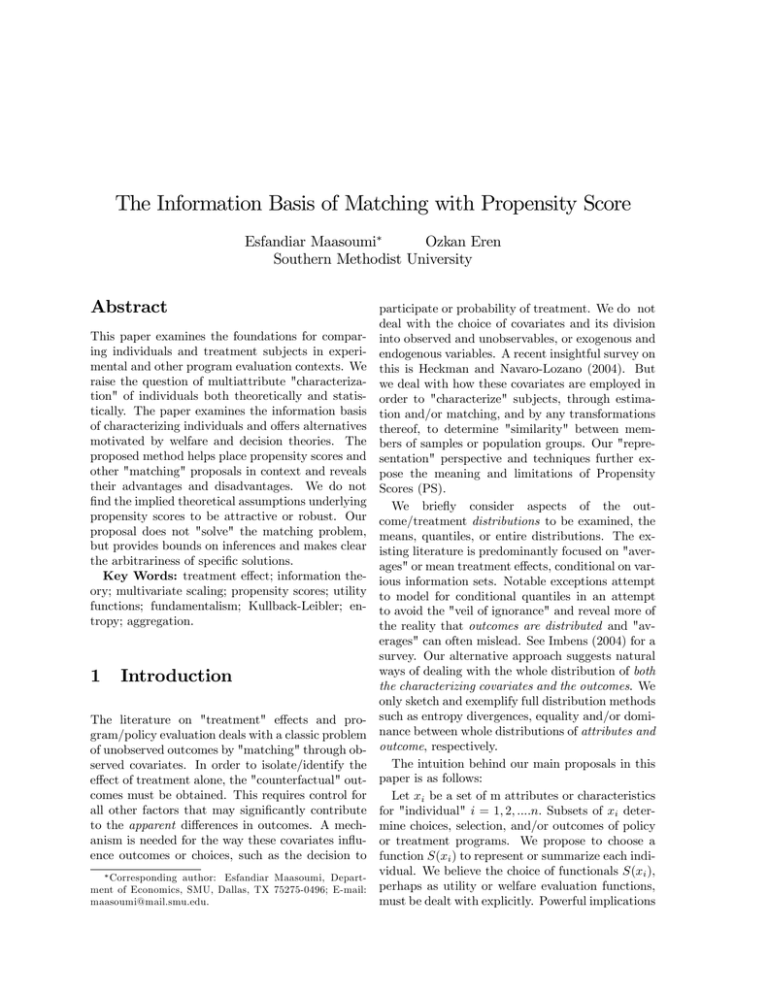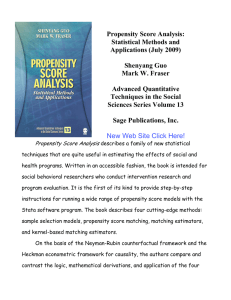The Information Basis of Matching with Propensity Score Abstract Esfandiar Maasoumi Ozkan Eren
advertisement

The Information Basis of Matching with Propensity Score
Esfandiar Maasoumi∗
Ozkan Eren
Southern Methodist University
Abstract
This paper examines the foundations for comparing individuals and treatment subjects in experimental and other program evaluation contexts. We
raise the question of multiattribute "characterization" of individuals both theoretically and statistically. The paper examines the information basis
of characterizing individuals and offers alternatives
motivated by welfare and decision theories. The
proposed method helps place propensity scores and
other "matching" proposals in context and reveals
their advantages and disadvantages. We do not
find the implied theoretical assumptions underlying
propensity scores to be attractive or robust. Our
proposal does not "solve" the matching problem,
but provides bounds on inferences and makes clear
the arbitrariness of specific solutions.
Key Words: treatment effect; information theory; multivariate scaling; propensity scores; utility
functions; fundamentalism; Kullback-Leibler; entropy; aggregation.
1
Introduction
The literature on "treatment" effects and program/policy evaluation deals with a classic problem
of unobserved outcomes by "matching" through observed covariates. In order to isolate/identify the
effect of treatment alone, the "counterfactual" outcomes must be obtained. This requires control for
all other factors that may significantly contribute
to the apparent differences in outcomes. A mechanism is needed for the way these covariates influence outcomes or choices, such as the decision to
∗ Corresponding
author: Esfandiar Maasoumi, Department of Economics, SMU, Dallas, TX 75275-0496; E-mail:
maasoumi@mail.smu.edu.
participate or probability of treatment. We do not
deal with the choice of covariates and its division
into observed and unobservables, or exogenous and
endogenous variables. A recent insightful survey on
this is Heckman and Navaro-Lozano (2004). But
we deal with how these covariates are employed in
order to "characterize" subjects, through estimation and/or matching, and by any transformations
thereof, to determine "similarity" between members of samples or population groups. Our "representation" perspective and techniques further expose the meaning and limitations of Propensity
Scores (PS).
We briefly consider aspects of the outcome/treatment distributions to be examined, the
means, quantiles, or entire distributions. The existing literature is predominantly focused on "averages" or mean treatment effects, conditional on various information sets. Notable exceptions attempt
to model for conditional quantiles in an attempt
to avoid the "veil of ignorance" and reveal more of
the reality that outcomes are distributed and "averages" can often mislead. See Imbens (2004) for a
survey. Our alternative approach suggests natural
ways of dealing with the whole distribution of both
the characterizing covariates and the outcomes. We
only sketch and exemplify full distribution methods
such as entropy divergences, equality and/or dominance between whole distributions of attributes and
outcome, respectively.
The intuition behind our main proposals in this
paper is as follows:
Let xi be a set of m attributes or characteristics
for "individual" i = 1, 2, ....n. Subsets of xi determine choices, selection, and/or outcomes of policy
or treatment programs. We propose to choose a
function S(xi ) to represent or summarize each individual. We believe the choice of functionals S(xi ),
perhaps as utility or welfare evaluation functions,
must be dealt with explicitly. Powerful implications
of welfare axioms of “fundamentality”, "impartiality", and “anonymity” may be invoked which partially justify the same "common representations"
for everyone’s preferences, in functional forms and
for “representative agent” formalisms; see Kolm
(1977) and Maasoumi (1986a). Simply put, if we
enter into a preference function all the attributes
that would matter (i.e., as m increases indefinitely),
the need for ex post and often arbitrary heterogeneity in functional representations and other approximations would be diminished. There are philosophical and empirical/data availability issues bearing
upon this "ideal", however, leading to practical admission of heterogeneity as well as functional approximations. In what follows, we focus on the
cases in which the assumption of "selection on observables" is plausible.
or the “observer’s” or policy maker’s assessments
for individual i. Let us define the following Generalized Multivariate GE measure of closeness or
diversity between the m densities of the chosen m
attributes:
Dβ (S, X; α) =
m
X
j=1
n
X
αj {
Si [(Si /Xij )β −1]/β(β+1)}
i=1
(1)
where αj s are the weights attached to each attribute.
P Minimizing Dβ with respect to Si such
that
Si = 1, produces the following “optimal”
aggregation functions:
m
X
−β −1/β
Si ∝ (
αj Xij
)
, β 6= 0, −1
(2)
j
2
Optimal
Functions
Multiattribute
Let Xij denote a measure of attribute j =
1, 2, ..., m, associated with individual (unit, household, country) i = 1, 2, ...., n. Define the covariate matrix X = (Xij ), Xi its ith row, Xj its
jth column, and consider any scalar function of
the matrix X. Examples of such scalar functions
are inequality measures or Social Welfare Functions
(SWFs), or propensity scores. It has proven difficult to develop “consensus” axioms which may
characterize an ideal scalar measure of X, such as
aggregators or inequality measures
Our approach is based on measures of closeness
and affinity which may identify either attributes
that are similar in some sense, and/or determine
a “mean-value”, or aggregate, which most closely
represents the constituent attributes. The difficulty
of selecting a measure of "similarity" has had some
resolution in “information theory” which seems to
suggest members of the Generalized Entropy (GE)
family as ideal criteria of “closeness” or “divergence”. Axiomatic characterization of GE is, however, beyond the scope of the present paper. The
interested reader may refer to Maasoumi (1993).
Following Maasoumi (1986a), let Si denote the
aggregate or mean function for the ith unit. It
makes little difference to our approach whether Si
is interpreted as an individual’s utility evaluations
α
Si ∝ Πj Xijj , β = 0
Si ∝
X
j
αj Xij , β = −1
(3)
(4)
These are, respectively, the hyperbolic, the generalized geometric, and the weighted means of the
attributes, see Maasoumi (1986a). Noting the
“constant elasticity of substitution”, σ = 1/(1+β),
these functional solutions include many of the well
known utility functions in economics, as well as
some arbitrarily proposed aggregates in empirical
applications. For instance, the weighted arithmetic
mean subsumes a popular “composite welfare indicator” based on the principal components of X,
when αj s are the elements of the first eigen vector
of the X 0 X matrix; see Ram (1982) and Maasoumi
(1989a).
The “divergence measure” Dβ (.) forces a choice
of an aggregate vector S= (S1 , S2 ,........,Sn ) with a
distribution that is closest to the distributions of its
constituent variables. This is especially desirable
when the goal of our analysis is the assessment of
distributed outcomes, such as treatment effects.
But it is desirable generally since, empirically, we
have no other "information" than the distribution
of variables. Information theory establishes that
any other S would be extra distortive of the objective information in the data matrix X in the sense
of Dβ (.). Elsewhere it has been argued that such
a distributional criterion is desirable for justifying
choices of utility, production, and cost functionals since such choices should not distort the actual
market allocation signals that are in the observed
data. The distribution of the data reflects the outcome of all decisions of all agents in the economy;
see Maasoumi (1986b). The divergence criterion
here is αj -weighted sum/average of pairwise GE
divergences between the “distributions” S and Xj ,
the jth attribute/column in X.1
2.1
A Closer Look
The reason we should explicitly deal with this problem of representation is to avoid implicit aggregation rules and representations which may not be
tenable when exposed. For instance, in the propensity scores method a linear function of x would
imply infinite substitutability between individual
characteristics and other covariates! Any scalar
functional of x is a summary measure of it, and
possesses an induced "distribution". This summary distribution must not be incompatible with
the information available on its constituent variables. While there are no consensus criteria for
"closeness" or similarity in sciences, there are some
very good ones that are supported by well thought
out axioms and properties. The axiom system that
identifies GE is constructive and is to be appreciated as an important breakthrough in organizing
learning and knowledge; see Maasoumi (1993). The
“fundamental welfare axioms” of symmetry, continuity, Principle of Transfers, and decomposability
identify GE as the desirable scale invariant family
of relative "inequality" measures.
In the context of our discussion above, PS first
takes a convenient function (typically linear, but
often augmented with polynomial terms), g(x) say,
and then transforms this into the unit interval
by inversion through some cumulative distribution
function (CDF), F say; Normal or logistic CDFs
predominate in determining "treatment probability". While we may view this last transformation
as a convenient standardization, we are less comfortable with its meaning. Firstly, neither g(x)
nor F (g(x)) has any clear justification as a representation of individuals/households/policy mak1 In unpublished work, the authors have considered hyperbolic means of these same pairwise divergences. This generalization is capable of producing more flexible functional
forms for Si .
ers in the sense made clear earlier. Second, the
parameter values, or indeed even semi-parametric
estimates of these functionals, are determined with
reference to optimal estimation rules which, again,
have no clear connection to optimal representation
or aggregation. In addition, the criticism in Heckman and Navaro-Lozano (2004), about the choice
of covariates in x being based on estimation and
model fit measures, applies. In addition, estimating
conditional means or quantiles, further impinges
on the plausibility of variable choices and coefficient values/factor loadings. Another discomforting aspect of the PS type solution is that the conditioning set is almost always made of the same
fundamental and frequently observed/cited x variables, whatever the experiment or treatment. In
the extreme, it is therefore possible that g(x) will
be called upon to determine selection into a drug
treatment program, as well as a welfare program!
Finally, matching based on propensity scores is a
decision on similarity of individuals based on estimated means of whole distributions, not the true
means. Furthermore, many different distributions
of individuals, and of heterogeneous groups, may
have similar or even the same means. The "control
function" method favored by Heckman and NavaroLozano (2004) is a second moment-based approach
to partially deal with this shortcoming of the PS
method.
3
An Application
We use the data from Dehejia and Wahba (1999),
which is based on Lalonde’s (1986) seminal study
on the comparison between experimental and nonexperimental methods for the evaluation of causal
effects.
The data combine the treated units
from a randomized evaluation of the National
Supported Work (NSW) demonstration with nonexperimental comparison units drawn from PSID
data. We restrict our analysis to the so-called
NSW-PSID-1 subsample consisting of the male
NSW treatment units, and the largest of the three
PSID subsample.2
The outcome of interest is real earnings in 1978;
the treatment is participation in the NSW treatment group. Control covariates are age, educa2 The same data set was also utilized in Becker and Ichino
(2000) and Smith and Todd (2005).
tion, real earnings in 1974 and 1975, and binary
variables for black, hispanic, marital status and a
degree. The treatment group contains 185 observations, the control group 2490 observations, for a total of 2675. PS specification includes the quadratic
terms for age, education, real earnings in 1974 and
1975, an interaction term between black and unemployment as well as the linear covariates described
above; Si , on the other hand, includes only the linear covariates.3
Table 1: ATT Estimations with Different Matching Techniques
ATT
Kullback-Leibler Divergence
(Standard Error)
Matching with Propensity Score
1654.566
Treated/Nontreated
Nontreated/Treated
0.0015
0.0014
(1042.161)
Matching with S(i), β=-1
2263.860
3.5109e-008
3.5106e-008
2.2390e-005
2.2456e-005
2.3058e-007
2.3079e-007
(1785.033)
Matching with S(i), β=-1/2
606.618
(1082.455)
Matching with S(i), β=-2/3
-557.414
(1663.907)
Matching with Φ(S(i)), β=-1
1545.518
Matching with Φ(S(i)), β=-1/2
-6929.172
0.0054
0.0051
1.9903e-005
1.9836e-005
4.2654e-004
4.2509e-004
(928.496)
(1709.479)
Matching with Φ(S(i)), β=-2/3
-1398.497
(1156.810)
In Table 1, matching is based on the aggregator functions, Si , as well as on the (Normal) CDF
transform of the Si ; Φ(Si ) . The latter is done
for direct comparability with the PS results, and
to draw out the impact of different substitution
and other parametric values.4 Matching based on
Si utilize the equal weights of αj (1/8), which is
the number of linear covariates. We use the resulting coefficients of the linear probit model for
αj when we match based on Φ(Si ). The standard
errors were obtained by simple bootstrap and are
given in parentheses. It is clear that inferences vary
dramatically depending on which functional forms,
weight parameters or βs are used. The case with
β = −1 is the case of "infinite substitutability" between covariates in the linear in parameters models. When less substitution is allowed, we have dramatically different results, including the reversal of
the sign for the ATT! This further reinforces the
criticisms offered recently in Heckman and NavaroLozano (2004), and Smith and Todd (2005).5
3 Unemployment is a binary variable defined for those who
report non-zero earnings in 1974.
4 We utilize nearest (single) neighbor matching in estimation of ATT. Kernel matching with different kernels/bandwidths produce similar results for ATT as of nearest neighbor matching.
5 We cannot use the interesting case of β = 0 when there
are binary variables since this will produce a zero value for
the generalized geometric function!
NOTES: (i) Propensity Score estimation include: age, age squared, education, education squared, real
earnings in 1974 and its square, real earnings in 1975 and its square, dummies for black, hispanic
marital status, nodegree, and an interaction term between black and nonemployment in 1974.
(ii) S(i) index include : age, education, real earnings in 1974, real earnings in 1975 and dummies for black,
hispanic, marital status and nodegree with weight given by 1/8; the number of linear covariates.
(iii) Φ(S(i)) includes the same specification as in S(i). The weights for Φ(S(i)) are the corresponding
probability weights from the probit equation. (iv) Standard errors are obtained via 500 bootstrap
replications. (v) Sample Size=2675, Treated Units=185 and Nontreated Units=2490. (v) Kullback-Leibler
Divergence Measure is obtained via a Gaussian kernel with fixed bandwidth, see text for further details.
In Table 1 we also provide an idea of proximity of the distributions of the propensity scores
between the experimental and the matched nonexperimental groups. This can be used to evaluate the efficacy of the matching technique employed (here, the nearest neighbor), not as in the
traditional way of assessing how close two or more
matched pairs are, but how well "similar" the two
samples are. This is of some importance given the
recent debate regarding the sensitivity and lack of
robustness to the choice of subsamples being used
by various investigators; see Smith and Todd (2005)
and response by Dahejia (2005). KL and other entropic measures give an idea of how far apart the
two distributions are.
Z The KL measure is defined as I(f, g) =
f
f log dx where f and g are the distributions
g
of the treated and control groups for a variable x,
respectively. A symmetrized version of this is the
well-known KL measure, but we report both of the
asymmetric measures which need to be averaged to
get KL in the third column of Table 1.6 The KL
measures are smaller for Si functions and the comparable Φ(Si ) than matching with the traditional
PS.
Figures 1-4 demonstrate the distribution of the
matched pairs by each technique. Specifically, these
are frequency distributions of PS for each individual, and the comparable transformation Φ(Si ).
6 The KL measures are obtained using a Gaussian kernel
and a fixed bandwidth.
Better "distribution" matches are obtained when and often distracted by statistical cost functions
that need to be justified.
Φ(Si ) is used with finite substitutability.
4
0
.2
.4
.6
Propensity Score
Untreated
.8
1
0
.2
Treated
.4
Propensity Score
Untreated
.6
.8
Treated
Figure 1: Frequency Distributions of PS and Φ(Si )
for β = −1
.5
.6
.7
.8
Propensity Score
Untreated
.9
Treated
1
.5
.6
.7
.8
Propensity Score
Untreated
.9
1
Treated
Figure 2: Frequency Distributions of Φ(Si ) for β =
−1/2 and β = −2/3
Traditional PS matching seems to correspond to
very different distributions of scores for the treated
and untreated. The non-experimental subjects in
the PSID were not considered for treatment, but
should have similar scores if the PS matching theory is valid. It is evident that at lower levels of substitution between characteristics, treatment probability is increased for the untreated sample. Again
these figures are computed using probit regression
estimates for the α weights in the Φ(Si ) functions.
Naturally, there would be some variation in these
results as we change the α values. Basing these
values, and the β, on estimation techniques is a decision to vary these graphs (PS values) to obtain
statistically optimal values for treatment/selection
probability. It is difficult a priori to see very many
contexts in which this would be reflective of policy
optimality, or in keeping with random assignment.
These results make clear the difficulties of assessing treatment effect, and expose the nature of
the implicit choices being made which appear disconnected from common program objectives. Data
"snooping", such as balancing, and estimation of
flexible or semi-parametric functional forms for PS
regressions, are attempts at changing the above distribution matches, but without the benefit of guidance by whole distribution measures of "match",
Treatment Effects: Stochastic Dominance
Following the IT reasoning above, it is possible
and desirable to assess the similarity, or any relation between the distributions of outcomes for
the treated and untreated/counterfactual groups.
Entropy measures such as KL can be used both to
quantify differences and to test if the differences
are significant. Any summary measure of this divergence/distance corresponds to a cardinal evaluation function that puts different weights on different subjects. This is true of the "average" treatment effects. Averages are particularly non-robust
to outliers and special outcomes which may have
nothing to do with the treatment. But averages,
or specific quantiles, have the advantage of easy
monetization for standard cost benefit analysis of
policy outcomes. It would be useful to examine
whether the distribution of outcomes is rankable
between two scenarios, no matter what weights are
attached to different subgroups. If it is desired to
assess the impact of treatment on the entire "sample", and to avoid full cardinalizationrios, such as
in "average effect" or choice of any quantile, weak
uniform ranking presents itself as a useful method.
Such rankings are achieved by tests for stochastic
dominance. Various orders of SD can provide guidance and eliminate certain summary measures. For
instance, if no First Order SD is found, one cannot
employ averages, medians, and other single quantiles to summarize "the" treatment effect.
Let X and Y be two variables. Let U1 denote the
class of all utility functions u such that u0 ≥ 0, (increasing). Also, let U2 denote the class of all utility
functions in U1 for which u00 ≤ 0 (strict concavity).
Assume F (x) and G(x) are continuous and monotonic cumulative distribution functions (CDFs) of
X and Y , respectively. X First Order Dominates
Y if F is everywhere to the right of G. X Second
Order dominates Y if integrated F is everywhere to
the right of integrated G. Lower order dominance
implies higher order ones. See Linton et al (2005)
for statistical tests of the relevant hypotheses. Below we examine the sample values graphically. No
SD rankings for DW data
20
0
4.1
10
(Order 1)
0
.2
5
.4
F(x)
.6
Integrated F(x)
15
.8
1
significance levels are reported as necessary descriptions cannot be included in this limited space.
0
20000
Support
40000
nontreated
60000
0
20000
Support
treated
40000
60000
nontreated
Figure 6: CDFs and Integrated CDFs for Φ(Si ) for
β = −2/3
The case of β = −1/2 is qualitatively identical to
this case.
10
(Order 1)
0
0
.2
5
.4
F(x)
.6
Integrated F(x)
15
.8
1
20
treated
0
20000
Support
treated
40000
60000
0
nontreated
20000
Support
treated
40000
60000
nontreated
10
5
(Order 1)
Integrated F(x)
.6
F(x)
.4
[1] Becker, S. O. and A. Ichino (2000), "Estimation of Average Treatment Effect Based on
Propensity Score", Stata Journal, 2, 1-19.
0
.2
0
References
Dahejia, R.H. (2005),"Program evaluation as a
Decision Problem", Journal of Econometrics,
125, 141-173.
15
.8
1
20
Figure 3: CDFs and Integrated CDFs of Propensity
Score (FSD not ruled out, SSD indicated)
Similar results for the CDFs and Integrated CDFs
for Si when β = −1; FSD not ruled out, SSD likely.
0
20000
Support
treated
40000
60000
0
nontreated
20000
Support
treated
40000
60000
nontreated
Figure 4: CDFs and Integrated CDFs for Si for
β = −1/2
[3] Deheija, R. and S. Wahba (2002), “Propensity Score-Matching Methods for Nonexperimental Causal Studies,” Review of Economics
& Statistics, 84, 151-161.
[4] Granger, C., E. Maasoumi and J. S. Racine
(2004), "A Dependence Metric for Possibly
Nonlinear Time Series", Journal of Time Series Analysis, vol. 25, 5, pages 649-669.
[5] Heckman, J. and S. Navarro-Lozano (2004),
“Using Matching, Instrumental Variables, and
Control Functions to Estimate Economic
Choice Models,” Review of Economics &
Statistics, 86, 30-57.
[6] Imbens, G.W. (2004), “Nonparametric Estimation of Average Treatment Effects Under
Exogeneity: A Review,” Review of Economics
& Statistics, 86, 4-29.
10
(Order 1)
0
0
.2
5
.4
F(x)
.6
Integrated F(x)
15
.8
1
20
This case is instructive. The CDFs cross, indicating different groups are impacted differently and
not uniformly. A discussion of averages and quantiles leaves the policy maker in a quandary. But
since even SSD is not certain, a simple risk aversion, or inequality aversion, would not allow the
policy maker to make uniform statements about
program effects. Given the indication of 3rd order
SD, it appears that only a policy maker, that is a
welfare summary measure, which cares increasingly
more about transfers at the lower end of earnings
distribution, might declare the program a benefit
(irrespective of costs). The case for β = −2/3 is
qualitatively similar to the case of β = −1/2.
[2] Dahejia, R., and S. Wahba (1999), "Causal
Effects in Non-Experimental Studies: Reevaluating the evaluation of training programs",
Journal of American Statistical Association,
94, 1053-1062.
0
20000
Support
treated
40000
nontreated
60000
0
20000
Support
treated
40000
60000
nontreated
Figure 5: CDFs and Integrated CDFs for Φ(Si ) for
β = −1
[7] Kolm, S.C. (1977),“Multidimensional egalitarianism,” Quarterly Journal of Economics, 91,
1-13.
[8] Lalonde, R. (1986),"Evaluating the Economet- [19] __________(1980),“The class of additively decomposable inequality measures,”
ric evaluations of the Training Programs with
Econometrica, 48, 613-625.
Experimental Data", American Economic Review, 76, 604-620.
[20] Smith, J. A. and P.E. Todd (2005),"Does
Matching overcome LaLonde’s critique of non[9] Linton, O., E. Maasoumi, and Y. J. Whang
experimental estimators", Journal of Econo(2005),"Consistent Testing for Stochastic
metrics,125, 305-353.
Dominance under general Sampling Schemes",
Review of Economic Studies, forthcoming.
[10] Maasoumi, E.(1986a),“The Measurement and
Decomposition of Multi-Dimensional Inequality,” Econometrica, 54, 991-97.
[11] _____________(1986b),“Unknown regression functions and efficient functional
forms:
An interpretation,” Advances in
Econometrics, 5, 301-9.
[12] Maasoumi, E.(1989a),“Composite Indices of
Income and Other Developmental Indicators :
A General Approach,” Research on Economic
Inequality, Vol. 1, 269-286.
[13] ___________. (1993),“A Compendium
to Information Theory in Economics and
Econometrics,” Econometric Reviews, Vol 12,
3, 1-49.
[14] Maasoumi,
E.,
and G. Nickelsburg
(1988),“Multivariate Measures of Well
Being and an Analysis of Inequality in the
Michigan Data,” Journal of Business and
Economic Statistics, 6, 3, 327-334.
[15] Ram, R.(1982),“Composite Indices of Physical
Quality of Life, Basic needs Fulfillment, and
Income : A ·Principal Component· representation,” Journal of Development Economics,
11, 227-47.
[16] Sen, A. (1970a) Collective choice and social welfare, Holden Day: San Francisco,
(reprinted, North-Holland, 1979).
[17] _______(1970b),“Degrees of cardinality
and aggregate partial orderings,” Econometrica, 43, 393-409.
[18] ________(1977) ,“On Weights and Measures: Informational constraints in social welfare analysis,” Econometrica, 45, 7, 1539-1572.





